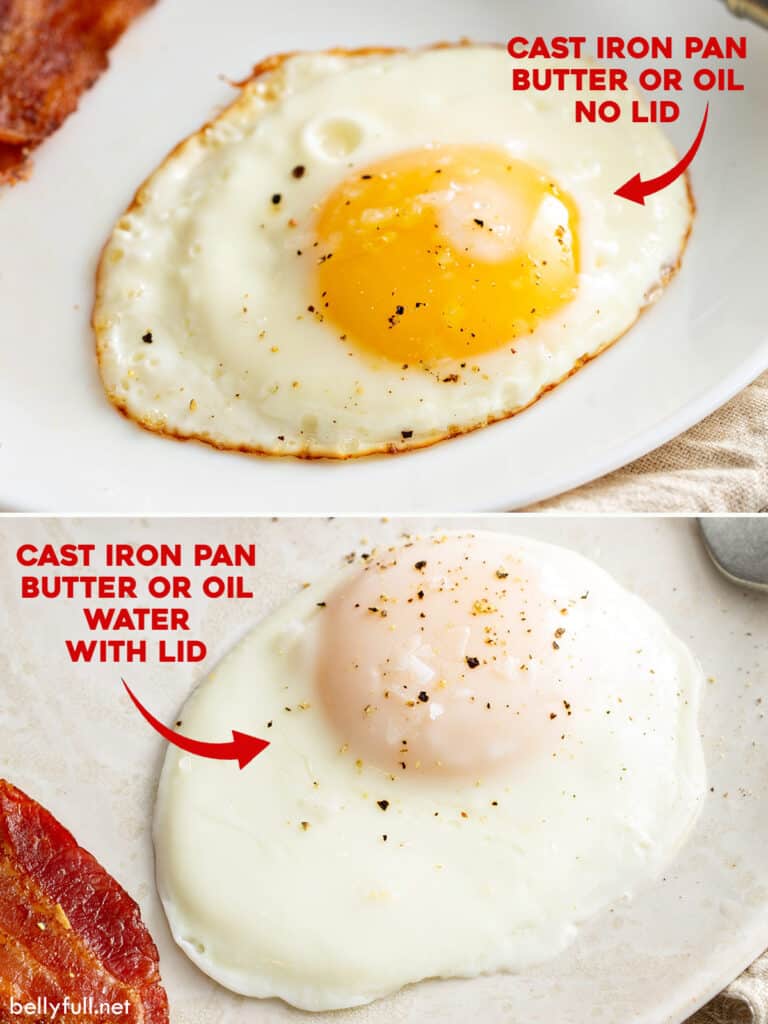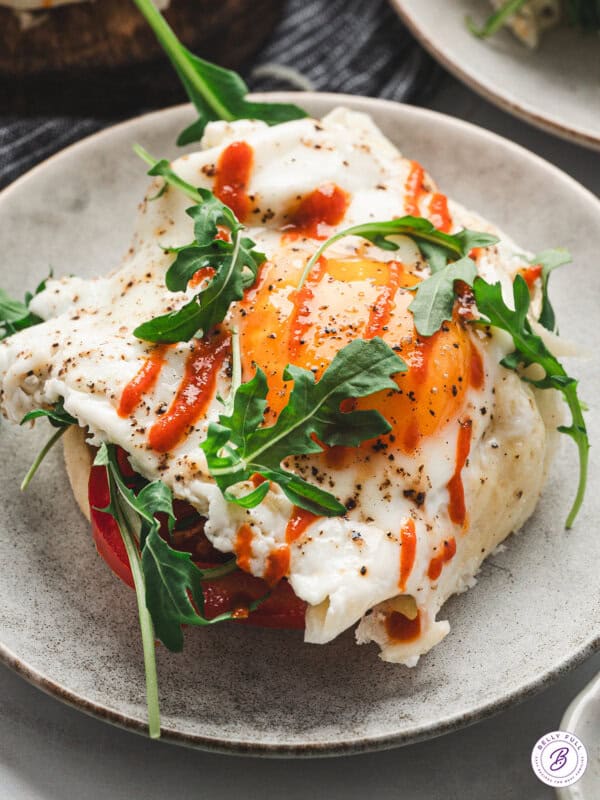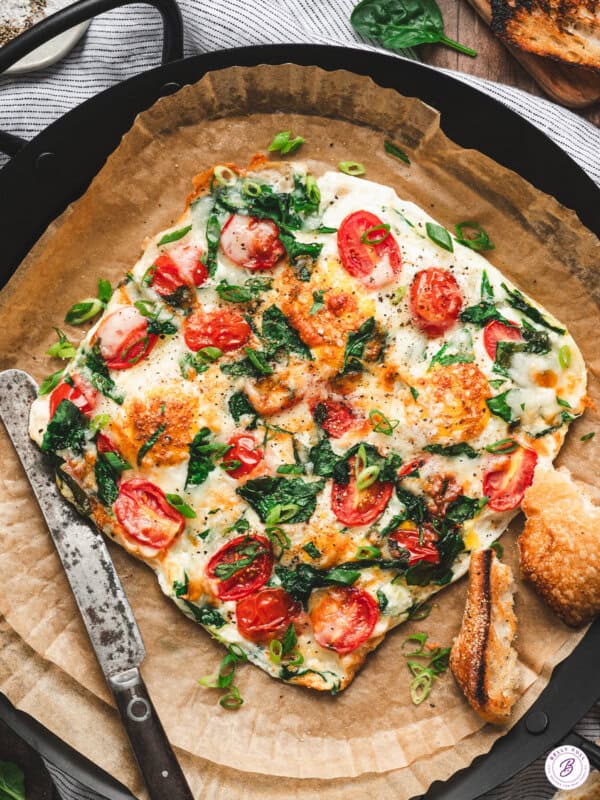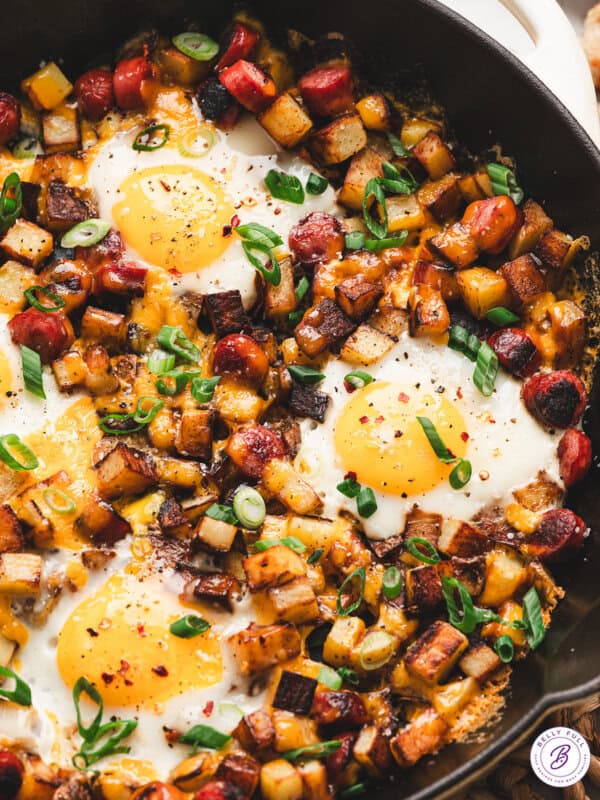Perfect Fried Eggs
Published
Published
Don’t know how to fry an egg? Follow these simple steps and recipe on how to make the absolute best fried egg with crispy, golden edges and a perfectly runny yolk for sunny side up or medium-hard yolk for over easy.

Pin this now to find it later
Pin ItThis post may contain affiliate links. If you click on one and make a purchase, we may earn a small commission at no extra cost to you. We only recommend products we genuinely love.
In my kitchen, scrambled eggs and fried eggs are staples. We love them both so much, alternating between the two depending on whether they’re being served on their own, with something else, or just what suits our mood. Neither ever disappoint, though. You just can’t go wrong with eggs – they’re quick, easy, cheap, and delish!
Today we’re talking about 5 different methods to make a fried egg, including my favorite – one that has a tender white with lacy, crispy edges, and a gorgeous yellow runny yolk that begs to be broken into with some bread.
Not much is needed to prepare a fried egg. Really just a pan, a rubber spatula, a small bowl, butter (or oil), and a couple minutes. The perfection is in the details and execution.
Let’s do it!

Making the Perfect Fried Egg
- Use fresh eggs: While using week-old eggs is recommended for making hard boiled eggs, the opposite is true when making fried eggs. For a fried egg, you want the freshest eggs. A fresh egg has a round, firm yolk and a tight surrounding membrane, which prevents it from spreading.
- Butter or Oil: You can fry an egg with either butter or oil, it’s entirely a personal preference. Olive oil is a great choice and healthier, but you can’t deny the deliciousness of butter! You’ll need about 1/2 tablespoon, enough to coat the bottom of the pan and to keep the egg from sticking. NOTE about oil: so many recipes recommend basting the egg white with the hot oil, but I have never found this necessary to achieve a perfectly cooked fried egg. Plus, the oil splatters like crazy. No thanks. But it’s up to you!
- Crack the egg into a bowl first: Doing this allows you to pour the egg into the skillet at a low angle, which reduces hot butter (or oil) splatters and also helps yield a tighter, more evenly shaped egg.
- Best pan for fried eggs: For 1-2 eggs, you’ll need an 8-inch pan and for 3-4 eggs, you’ll need a 12-inch pan. You can fry an egg in any type of pan, really.
Cast Iron – Cast iron retains heat so well and really gets those egg whites super crispy.
Nonstick – The eggs easily glide right from the surface onto a plate.
Enameled Cast Iron – You get the benefits of both cast iron heat and nonstick. - Proper heat is key: Warm your pan over medium-high heat until it’s hot enough that a drop of water sizzles rapidly on contact. Then reduce the heat to medium before adding the butter or oil. The initial high heat will ensure that the egg does not stick to the pan, then lowering the heat makes sure the egg yolk doesn’t cook too fast while the egg white remains runny and raw.
How Long to Cook Fried Eggs
The total time to cook a fried egg really depends on the temperature of your burner and the pan you use, since not all pans conduct heat the same way. However, for the most part it will take about 2 minutes for a perfectly runny yolk and opaque whites. (For over-easy eggs, see below.)

How to Fry an Egg
Technique #1 (no lid, cast iron skillet – this renders a gorgeous runny yellow yolk, with crispy whites.)
- Crack an egg in a small ramekin and place it near the stove.
- Warm an 8-inch cast iron skillet over medium-high heat until it’s hot enough that a drop of water sizzles rapidly on contact.
- Reduce heat to medium and add in 1/2 tablespoon butter, moving it around to coat the pan.
- Gently pour the egg into the center of the pan (and watch out for splatters.)
- Let the egg cook until the edges are crisp and golden and egg white is opaque, but the yolk is still runny, 2 to 2 1/2 minutes.
- Transfer the cooked egg to a plate. Sprinkle with flaky sea salt and a couple turns of freshly ground black pepper, if desired.
Technique #2 (with lid, using water to steam, cast iron skillet – perfect for people who prefer to mask the sunny yolk with a thin layer of cooked egg white)
- Crack an egg in a small ramekin and place it near the stove.
- Warm an 8-inch cast iron skillet over medium-high heat until it’s hot enough that a drop of water sizzles rapidly on contact.
- Reduce heat to medium and add in 1/2 tablespoon butter, moving it around to coat the pan.
- Gently pour the egg into the center of the pan (and watch out for splatters.)
- Immediately drizzle 1 tablespoon of water around the outer parameter of the egg and cover with a lid.
- Cook for 2 minutes until the egg white is opaque and a thin layer of cooked egg white is over the yolk, but the yolk itself is still runny.
- Transfer the cooked egg to a plate. Sprinkle with flaky sea salt and a couple turns of freshly ground black pepper, if desired.

How to Make Over Easy Fried Eggs
Technique #3-5 (Over-Easy, Over-Medium, Over-Hard)
This method is perfect for those who don’t want any shiny egg white. Following either of the techniques listed above, once the egg is cooked sunny side up, you simply slide a thin spatula underneath the yolk and flip the egg over in the pan. Cook for an additional 10-30 seconds for over-easy, 30-60 seconds for over-medium, and 1-2 minutes for over-hard.
Fried Egg Video
More Ways to Cook Eggs!
- Life Changing Scrambled Eggs
- Perfect Hard Boiled Eggs
- How to Make an Omelette
- Poached Eggs
I hope you love this delicious and easy recipe – be sure to give it a review below! Also don’t forget to follow Belly Full on Facebook, Instagram, Pinterest, and YouTube!
How to Fry an Egg – Perfect Fried Eggs

Equipment
- Cast Iron or Nonstick pan (see notes in article)
Ingredients
- 1 large fresh egg
- 1/2 tablespoon butter
- Flaky sea salt, , for serving
- Freshly ground black pepper, , for serving
Instructions
Technique #1 (no lid, cast iron skillet – this renders a gorgeous runny yellow yolk, with crispy whites.)
- Crack an egg in a small ramekin and place it near the stove.
- Warm an 8-inch cast iron skillet over medium-high heat until it’s hot enough that a drop of water sizzles rapidly on contact.
- Reduce heat to medium and add in the butter, moving it around to coat the pan.
- Gently pour the egg into the center of the pan (and watch out for splatters.)
- Let the egg cook until the edges are crisp and golden and egg white is opaque, but the yolk is still runny, 2 to 2 1/2 minutes.
- Transfer the cooked egg to a plate. Sprinkle with flaky sea salt and a couple turns of freshly ground black pepper, if desired.
Technique #2 (with lid, using water to steam, cast iron skillet – perfect for people who prefer to mask the sunny yolk with a thin layer of cooked egg white.)
- Crack an egg in a small ramekin and place it near the stove.
- Warm an 8-inch cast iron skillet over medium-high heat until it’s hot enough that a drop of water sizzles rapidly on contact.
- Reduce heat to medium and add in the butter, moving it around to coat the pan.
- Gently pour the egg into the center of the pan (and watch out for splatters.)
- Immediately drizzle 1 tablespoon of water around the outer parameter of the egg and cover with a lid.
- Cook for 2 minutes until the egg white is opaque and a thin layer of cooked egg white is over the yolk, but the yolk itself is still runny.
- Transfer the cooked egg to a plate. Sprinkle with flaky sea salt and a couple turns of freshly ground black pepper, if desired.
Technique #3-5 Over-Easy, Over-Medium, and Over-Hard – perfect for those who don't want any shiny egg white.
- Following either technique #1 or #2 listed above, once the egg is cooked sunny side up, you simply slide a thin spatula underneath the yolk and flip the egg over in the pan. Cook for an additional 10-30 seconds for over-easy, 30-60 seconds for over-medium, and 1-2 minutes for over-hard.
Video
Nutrition
Nutritional information given is an automatic calculation and can vary based on the exact products you use and any changes you make to the recipe. If these numbers are very important to you, I would recommend calculating them yourself.











I like method #1! I recommend everyone has a cast iron pan. Makes the best bacon, too. Thanks for all the tips. Love a fried egg on a burger. YUM!
I love this recipe so much